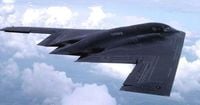On October 14, 2025, the skies over Texas buzzed with intrigue as a US Air Force B-52H Stratofortress, a nuclear-capable bomber, was tracked making a series of unusual maneuvers. The long-range, subsonic strategic bomber departed from Shreveport, Louisiana at precisely 1:18pm Eastern Time, according to flight tracking data reported by multiple outlets, including the Daily Mail. Its path took it through Arkansas, then into Oklahoma, and finally over the vast expanse of northern Texas, where it performed several loops and circles before continuing its mission.
The B-52H Stratofortress, described by the US Air Force as a heavy bomber capable of an array of missions, is hardly a relic of the Cold War despite its storied past. This particular flight, operating under the callsign 'TUFFF72,' reached an altitude of 26,000 feet and clocked speeds exceeding 554 miles per hour. While the Air Force has not officially disclosed the purpose of the flight, such high-profile sorties are often part of complex training exercises, strategic readiness operations, or, occasionally, serve as a show of force in an increasingly tense global security environment.
The B-52’s presence over Texas was not an isolated event. Just days before, on October 8, another B-52 took off from the same Shreveport base, following a different route into Mississippi and circling over Baton Rouge before returning home. These flights, while routine in the context of Air Force training, have sparked public curiosity and speculation, particularly given the aircraft’s formidable capabilities and its role in America’s nuclear and conventional deterrence.
According to the Daily Mail, the B-52H is capable of flying at altitudes up to 50,000 feet and can deliver both nuclear and precision-guided conventional ordnance with pinpoint accuracy anywhere in the world. The aircraft, which first entered service during the Cold War, remains a cornerstone of the US strategic arsenal. Its versatility is unmatched: it can conduct strategic attacks, provide close-air support, execute air interdiction, perform offensive counter-air missions, and even take on maritime operations such as anti-ship missions and mine-laying. In fact, during Operation Desert Storm, B-52s were responsible for dropping 40 percent of all coalition munitions, underscoring their critical role in large-scale operations.
Modern B-52s are far from outdated. They are equipped with advanced electro-optical viewing sensors, forward-looking infrared, and sophisticated targeting pods. These upgrades enable better targeting, more accurate battle assessments, and enhanced flight safety. Pilots routinely use night vision goggles to improve situational awareness and ensure safe operations during nighttime missions, a feature that has become standard in today’s high-stakes military environment. The aircraft’s ability to fire long-range missiles and deploy satellite-guided bombs keeps it relevant in an age of rapidly evolving technology.
Perhaps most notably, the B-52 is the only current US bomber that can be equipped with nuclear-tipped cruise missiles. Its role in ocean surveillance is equally impressive: two B-52s can monitor approximately 140,000 square miles of ocean surface in just two hours, providing the US Navy with unmatched reconnaissance and strike capabilities. With a fleet of 76 aircraft and ongoing upgrades—Rolls-Royce is among the companies vying to supply new, fuel-saving engines—the B-52 is expected to remain in service until at least 2050.
The recent high-profile flights come at a time of renewed focus on America’s strategic bomber fleet. On October 13, 2025, President Trump announced that the Pentagon is ordering 28 new B-2 Spirit stealth bombers, as reported by CBS News. The B-2, operated by the 509th Bomb Wing out of Whiteman Air Force Base in Missouri, has long been the tip of the spear for US air defense. In June 2025, seven B-2s participated in Operation Midnight Hammer, a precision strike on Iranian nuclear sites that showcased the bomber’s unique combination of long range, high payload, and stealth capabilities.
Col. Josh Wiitala, commander of the 509th Bomb Wing, described the operation as one of the most consequential raids of his career. "I think in terms of my lifetime, as an airman, this will be one of the most consequential raids that we've executed," Wiitala told CBS News. He emphasized the B-2’s singular combination of attributes: "There's a lot of long-range aircraft out there. There's a lot of aircraft that have a high payload. There's also other stealth aircraft out there. But the only one that combines all three is the B-2."
Stealth remains a closely guarded asset. Maj. Gen. Jason Armagost of Global Strike Command explained, "Stealth matters, and stealth matters even more today than it did when at its inception. Stealth is many things. It's shape, it's materials, it's tactics. And so, we protect our stealth capabilities in a way, such that the advantages don't accumulate to anyone else."
During Operation Midnight Hammer, the B-2s were escorted by stealth F-22 and F-35 fighters as they entered Iranian airspace, facing what military officials described as the most advanced adversary encountered to date. The bombers carried 30,000-pound Massive Ordnance Penetrator bombs, specifically designed to destroy deep underground targets. Chief Master Sgt. Frank Espinoza, who led the team responsible for loading the bombs, praised the flawless execution: "They all made it happen. Yeah. Flawlessly. Any time we get the call, we're going to deliver and we're not going to miss a step."
The B-52 and B-2 represent two ends of the US bomber spectrum: one a Cold War workhorse continually upgraded for modern missions, the other a stealthy, cutting-edge marvel designed to slip unnoticed into hostile territory. Both, however, remain vital to America’s ability to project power and deter adversaries, whether over the plains of Texas or in the skies above distant battlefields.
The recent B-52 flight over Texas, with its mysterious loops and classified objectives, is a vivid reminder that these aircraft are more than symbols—they are active participants in a world where readiness, flexibility, and technological superiority are as crucial as ever. The enduring presence of these bombers, backed by new investments and evolving technology, ensures that America’s strategic edge remains sharp, even as the nature of global conflict continues to change.




